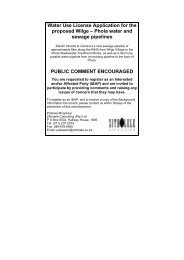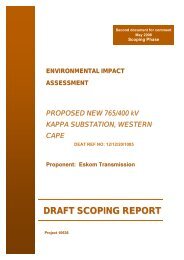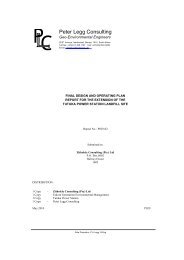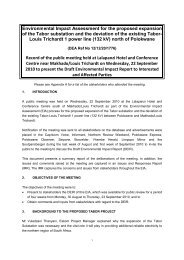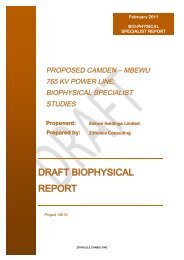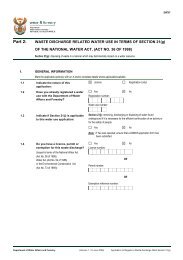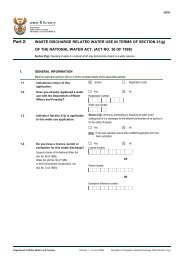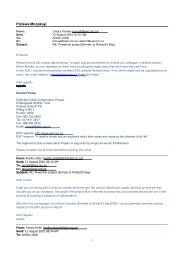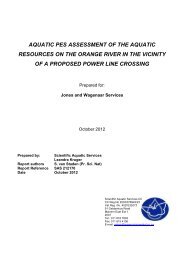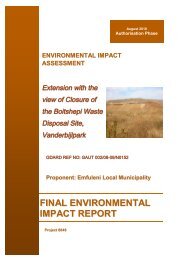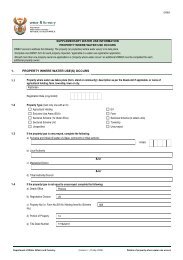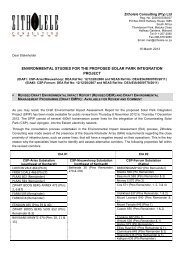Appendix I - Minutes of the Public Meeting.pdf - Zitholele.co.za
Appendix I - Minutes of the Public Meeting.pdf - Zitholele.co.za
Appendix I - Minutes of the Public Meeting.pdf - Zitholele.co.za
You also want an ePaper? Increase the reach of your titles
YUMPU automatically turns print PDFs into web optimized ePapers that Google loves.
Environmental Impact Assessment for <strong>the</strong> proposed expansion<br />
<strong>of</strong> <strong>the</strong> Tabor substation and <strong>the</strong> deviation <strong>of</strong> <strong>the</strong> existing Tabor-<br />
Louis Trichardt 1power line (132 kV) north <strong>of</strong> Polokwane<br />
(DEA Ref No 12/12/20/1776)<br />
Re<strong>co</strong>rd<strong>of</strong> <strong>the</strong> publicmeetingheld atLalapanziHotel andConference<br />
Centre nearMakhadoon Thursday,13May2010topresent<strong>the</strong> Draft<br />
S<strong>co</strong>pingReporttoInterested andAffectedParties<br />
Please see <strong>Appendix</strong> A foralist <strong>of</strong> <strong>the</strong> stakeholders who attended <strong>the</strong> meeting.<br />
1. INTRODUCTION<br />
A public meeting was held on Thursday, 13 May 2010 at 15:00 at <strong>the</strong> Lalapanzi Hotel and<br />
Conference Centre south <strong>of</strong> Makhado as part <strong>of</strong> <strong>the</strong> Environmental Impact Assessment (EIA)<br />
process to obtain environmental authorisation for <strong>the</strong> proposed expansion <strong>of</strong> <strong>the</strong> Tabor substation<br />
and <strong>the</strong> deviation <strong>of</strong> <strong>the</strong> existing Tabor-Louis Trichardt 1power line (132 kV) between Polokwane<br />
and Makhado/Louis Trichardt.<br />
Notification <strong>of</strong> <strong>the</strong> meeting was sent to all stakeholders on <strong>the</strong> database and advertisements were<br />
placed in <strong>the</strong> Capri<strong>co</strong>rn Voice, Informant, Nor<strong>the</strong>rn Review Weekend, Polokwane Express,<br />
Polokwane Observer, Seipone, Bosvelder, Vhembe Herald, Limpopo Mirror and <strong>the</strong><br />
Soutpansberger during <strong>the</strong> last week <strong>of</strong> April 2010 to invite <strong>the</strong> public to <strong>the</strong> meeting to discuss <strong>the</strong><br />
Draft S<strong>co</strong>ping Report.<br />
The meeting was attended by 16 stakeholders, which included Government representatives, three<br />
Eskom <strong>of</strong>ficials and two people from <strong>Zitholele</strong> Consulting.<br />
This document presents asummary report <strong>of</strong> <strong>the</strong> deliberations <strong>of</strong> <strong>the</strong> meeting. In addition <strong>the</strong><br />
issues and <strong>co</strong>mments raised at <strong>the</strong> meeting are captured in an Issues and Responses Report. This<br />
report captures <strong>the</strong> <strong>co</strong>ncerns and issues from stakeholders throughout <strong>the</strong> EIA.<br />
2. OBJECTIVES OFTHE MEETING<br />
The objectives <strong>of</strong> <strong>the</strong> meeting were to:<br />
• Present to stakeholders <strong>the</strong> Draft S<strong>co</strong>ping Report (DSR) <strong>of</strong> this Environmental Impact<br />
Assessment (EIA), which wasavailable for publicreview from 30 April to 28 May 2010;<br />
• Obtain <strong>co</strong>mments and inputs from stakeholders with regard to <strong>the</strong> DSR; and<br />
• Obtain suggestions for <strong>the</strong> planning, impact assessment and public participation processes<br />
ahead.<br />
1
3. BACKGROUND TO THE PROPOSED TABOR PROJECT<br />
Mr Vuled<strong>za</strong>ni Thanyani, Eskom Project Manager explained why <strong>the</strong> expansion <strong>of</strong> <strong>the</strong> Tabor<br />
Substation was necessary and <strong>the</strong> vital role it will play in providing additional reliable electricity to<br />
<strong>the</strong> nor<strong>the</strong>rn region <strong>of</strong> South Africa.<br />
The Tabor Substation must be upgraded because:<br />
• The Polokwane area has experienced good e<strong>co</strong>nomic growth, due to urban growth,<br />
electrification, mining and industriali<strong>za</strong>tion;<br />
• Eskom has to support this growth in <strong>the</strong> Limpopo by streng<strong>the</strong>ning <strong>the</strong> transmission<br />
network that will also add extra power supply options to <strong>the</strong> South African electricity grid;<br />
• The 275kV Tabor-Spencer and 400kV Tabor-Witkop power lines have received<br />
environmental authorisation from <strong>the</strong> Department <strong>of</strong> Environmental Affairs in 2007 and<br />
2008 respectively; and<br />
• In order to integrate <strong>the</strong>se additional lines into <strong>the</strong> Tabor Substation it must be upgraded<br />
and expanded to carry <strong>the</strong> increased load <strong>of</strong> <strong>the</strong> new transmission power lines.<br />
4. ENVIRONMENTAL IMPACT ASSESSMENT AND AUTHORISATION PROCESS<br />
Ms Jacqui Hex, <strong>Zitholele</strong> Consulting gave an overview <strong>of</strong> <strong>the</strong> EIA process and explained and<br />
presented <strong>the</strong> <strong>co</strong>ntents<strong>of</strong> <strong>the</strong> DSR.<br />
The purpose <strong>of</strong> <strong>the</strong> DSR is to identify alternatives and potential impacts requiring more detailed<br />
investigation in <strong>the</strong> Environmental Impact Report phase. This is based on:<br />
• Literature review;<br />
• Pr<strong>of</strong>essional input (technical and environmental); and<br />
• <strong>Public</strong> input.<br />
Potential impacts to be investigated during <strong>the</strong> EIA process are:<br />
• Visual;<br />
• Terrestrial flora and fauna;<br />
• Heritage resources;<br />
• Soils and land capability;<br />
• Avi-fauna; and<br />
• Society.<br />
5. PUBLIC PARTICIPATION PROCESS<br />
Mr Joubert gave an overview <strong>of</strong> <strong>the</strong> public participation process that was followed to date and <strong>the</strong><br />
next steps to be followed in <strong>the</strong> process. He also highlighted <strong>the</strong> role <strong>of</strong> stakeholders and <strong>the</strong> value<br />
that <strong>the</strong>y can <strong>co</strong>ntribute to aproject.<br />
Please see <strong>Appendix</strong> B forall <strong>the</strong> presentations delivered at <strong>the</strong> meeting.<br />
2
6. DISCUSSION<br />
The questions asked, responses provided and any o<strong>the</strong>r <strong>co</strong>mments made during <strong>the</strong> public<br />
meeting are summarised below:<br />
1. Ms Joyce Mashiteng (Eskom) asked that <strong>the</strong> proposed size <strong>of</strong> <strong>the</strong> expansion 300 metres X<br />
300 metres be explained to <strong>the</strong> meeting. Ms Hex said <strong>the</strong> area would be <strong>the</strong> size <strong>of</strong> three<br />
school football/rugby fields.<br />
2. Ms Olga Ligege (Department <strong>of</strong> Agriculture, Forestry and Fisheries - DAFF) said her<br />
Department uses a different list <strong>of</strong> protected plants than that <strong>of</strong> <strong>the</strong> Department <strong>of</strong><br />
Environmental Affairs. Ms Hex thanked Ms Ligege for this information and said this will be<br />
taken into <strong>co</strong>nsideration during <strong>the</strong> specialist studies and requested a<strong>co</strong>py <strong>of</strong> <strong>the</strong> list.<br />
3. Mr Modige Monakedi (Limpopo Department <strong>of</strong> Agriculture) asked what route <strong>the</strong> line to be<br />
deviated will follow and how big <strong>the</strong> impact will be on <strong>the</strong> land. Ms Hex explained that <strong>the</strong><br />
impact is dependent on <strong>the</strong> deviation alternative. She explained that <strong>the</strong>re are three <strong>co</strong>rridor<br />
alternatives that will be assessed for <strong>the</strong> proposed deviation. During <strong>the</strong> impact assessment<br />
phase <strong>of</strong> <strong>the</strong> project <strong>the</strong> impacts <strong>of</strong> each <strong>of</strong> <strong>the</strong>se alternatives on <strong>the</strong> environment (social,<br />
bio-physical and cultural) will be assessed and determined. This information will <strong>the</strong>n be<br />
presented in <strong>the</strong> Draft Environmental Impact Report and stakeholders will have an<br />
opportunity to <strong>co</strong>mment on <strong>the</strong>se findings. Based on this information toge<strong>the</strong>r with<br />
stakeholder <strong>co</strong>mments a preferred alternative will be presented to <strong>the</strong> Department <strong>of</strong><br />
Environmental Affairs for adecision.<br />
4. Mr Khathutshelo Ramukosi (Limpopo Department <strong>of</strong> Agriculture) asked if <strong>the</strong>re are any land<br />
claims against <strong>the</strong> land Eskom has earmarked for <strong>the</strong> expansion and should <strong>the</strong>re be any<br />
claims, if <strong>the</strong> claimants would be <strong>co</strong>mpensated for <strong>the</strong>ir loss <strong>of</strong> land. Ms Mashiteng said <strong>the</strong><br />
chances are small that <strong>the</strong>re are any outstanding land claims against <strong>the</strong> land on which <strong>the</strong><br />
substation is built upon, because Eskom already has aservitude on this property and it is<br />
registered as such in <strong>the</strong> Surveyor-General’s <strong>of</strong>fice. However, Eskom will clarify if <strong>the</strong>re are<br />
any land claims against <strong>the</strong> land needed for <strong>the</strong> expansion <strong>of</strong> <strong>the</strong> substation and will fur<strong>the</strong>r<br />
investigate <strong>the</strong> matter.<br />
5. Mr Monakedi asked what is being done by Eskom to lessen <strong>the</strong> impact <strong>of</strong> power lines on<br />
people. Ms Mashiteng said studies undertaken during an EIA will <strong>co</strong>me up with aproposed<br />
route with <strong>the</strong> lowest impact on <strong>the</strong> environment as well as people living in <strong>the</strong> affected<br />
area. After Environmental Authorisation has been granted, Eskom <strong>of</strong>ficials walk <strong>the</strong> entire<br />
route <strong>of</strong> aproposed power line to negotiate <strong>the</strong> exact position <strong>of</strong> pylons with landowners. Mr<br />
Thanyani added that farmers can plant maize, wheat, etc underneath power lines and<br />
animals can also graze <strong>the</strong>re, but structures such as houses and buildings are not<br />
permitted underneath power lines.<br />
3
6. Mr Monakedi said he is <strong>co</strong>ncerned about people who <strong>co</strong>uld be negatively affected, because<br />
<strong>the</strong>re have been instances in <strong>the</strong> Limpopo where Eskom <strong>co</strong>nstructed power lines without<br />
<strong>co</strong>nsulting <strong>the</strong> affected people. People have also been moved without receiving any<br />
<strong>co</strong>mpensation. Ms Mashiteng said unfortunately some mistakes were made. Eskom is<br />
aware <strong>of</strong> <strong>the</strong> problems in <strong>the</strong> Burgersfort area and is in <strong>the</strong> process <strong>of</strong> rectifying that<br />
mistake. The reason why this meeting is being held is to prevent mistakes like that. An EIA<br />
done for Eskom will always be <strong>co</strong>nsultative and <strong>the</strong> public participation process is,<br />
<strong>the</strong>refore, very important.<br />
7. Mr Mfundi Songo (Eskom) said <strong>the</strong> expansion <strong>of</strong> <strong>the</strong> Tabor substation and o<strong>the</strong>r<br />
developments planned in <strong>the</strong> Limpopo are to <strong>the</strong> assist with <strong>the</strong> electrification <strong>of</strong> <strong>the</strong><br />
province and reduce <strong>the</strong> electricity backlog in <strong>the</strong> province.<br />
7. NEXT STEPS<br />
The next step in <strong>the</strong> process would be for <strong>the</strong>se <strong>co</strong>mments to be included in <strong>the</strong> Final S<strong>co</strong>ping<br />
Report. The Final S<strong>co</strong>ping Report will <strong>the</strong>n be submitted to <strong>the</strong> Department <strong>of</strong> Environmental<br />
Affairs (DEA)for <strong>the</strong>ir review and approval.<br />
Participants were reminded that <strong>the</strong>y all have <strong>the</strong> opportunity to <strong>co</strong>mment on <strong>the</strong> DSR until 28<br />
May 2010.<br />
Once <strong>the</strong> DEA has approved <strong>the</strong> report, <strong>the</strong> next phase <strong>of</strong> <strong>the</strong> project will <strong>co</strong>mmence, which is<br />
<strong>the</strong> Impact Assessment Phase. In this phase, <strong>the</strong> specialist studies will be <strong>co</strong>nducted. The<br />
findings <strong>of</strong> <strong>the</strong> specialist studies will be in<strong>co</strong>rporated in <strong>the</strong> Draft Environmental Impact Report.<br />
Copies <strong>of</strong> <strong>the</strong> report will be made available to stakeholders for <strong>co</strong>mment and review.<br />
A meeting to present <strong>the</strong>se findings is also being planned towards <strong>the</strong> end <strong>of</strong> 2010 and<br />
stakeholders will again be invited.<br />
4
EIA PROCESS<br />
Presentation <strong>of</strong> DraftS<strong>co</strong>ping Report<br />
<strong>Public</strong> <strong>Meeting</strong><br />
TaborSubstationProject<br />
Proposedupgrade /extension<strong>of</strong> <strong>the</strong> Tabor Substation and<br />
Deviation<strong>of</strong> <strong>the</strong> Tabor-Louis Trichardt132kVpowerline<br />
Agenda<br />
14:30 Registration<br />
15:00 Wel<strong>co</strong>me,introduction andobjectives<br />
15:10 Backgroundto project<br />
15:30 Questionsfor clarification<br />
15:45 PresentationonDSR<br />
16:15 <strong>Public</strong>participation<br />
16:30 Discussionon DraftS<strong>co</strong>ping Report<br />
17:00 Nextstepsandclosure<br />
May 2010<br />
Wel<strong>co</strong>meand Introduction<br />
• Vuled<strong>za</strong>niThanyani -Eskom<br />
• JoyceMashiteng -Eskom<br />
Wel<strong>co</strong>meand Introduction<br />
AndreJoubert<br />
• DuduHadebe -Eskom<br />
• MfundiSongo -Eskom<br />
• JacquiHex -<strong>Zitholele</strong>Consulting<br />
• AndreJoubert -<strong>Zitholele</strong>Consulting<br />
Objectives<strong>of</strong><strong>the</strong> <strong>Meeting</strong><br />
Objectives<strong>of</strong> <strong>the</strong> <strong>Meeting</strong><br />
• Present <strong>the</strong> <strong>co</strong>ntents <strong>of</strong> <strong>the</strong> DraftS<strong>co</strong>ping Report<br />
• Obtain<strong>co</strong>mments and inputs fromstakeholders<br />
on <strong>the</strong> Draft S<strong>co</strong>ping Report<br />
• Obtainsuggestions for <strong>the</strong> planning, impact<br />
assessment and public participationprocesses<br />
ahead<br />
• Weare here to:<br />
SHARE information<br />
OBTAIN<strong>co</strong>mments<br />
1
Guidelinesfor ProductiveDiscussion<br />
•Focus onissues, not people<br />
•Courtesy<br />
•One person at a time<br />
•Workthrough facilitator<br />
•Agreeto disagree<br />
•Cellphones onsilent<br />
Overview<strong>of</strong> <strong>the</strong> ProposedProject<br />
Brief background to project<br />
Eskom<br />
Agenda<br />
15:45 Presentationon DSR<br />
16:15 <strong>Public</strong> participation<br />
16:30 Discussionon DraftS<strong>co</strong>ping Report<br />
17:00 Nextstepsand closure<br />
EnvironmentalImpactAssessment<br />
Process<br />
Jacqui Hex<br />
Purpose<strong>of</strong><strong>the</strong> EIA process<br />
• Tosatisfy requirements <strong>of</strong>:<br />
–National Environmental Management Act<br />
–National Heritage Resources Act<br />
• Identify potential environmental impacts<br />
(social and biophysical) and determine <strong>the</strong>ir<br />
likely significance<br />
• Allow for public involvement<br />
• Inform Eskom’s decision-making<br />
• Inform Environmental Authority’s decision<br />
February 2010<br />
March 2010<br />
April 2010<br />
June 2010<br />
September 2010<br />
November 2010<br />
Initial Application Phase<br />
Authority Review<br />
è<br />
è<br />
è<br />
Authority Review<br />
è<br />
è<br />
Applicationform<br />
S<strong>co</strong>ping Report Phase<br />
Initial public <strong>co</strong>nsultation<br />
Draft S<strong>co</strong>ping Report inc.<br />
Plan <strong>of</strong>Study for EIR<br />
Final S<strong>co</strong>ping Reportinc.<br />
Plan<strong>of</strong> Study for EIR<br />
EIR Phase<br />
Draft EIR &EMP<br />
Final EIR &RevisedDraft EMP<br />
Authority Review<br />
March 2011<br />
Environmental Authorisation<br />
è<br />
Weare<br />
here<br />
è<br />
Opportunity forAppeal<br />
2
Purpose<strong>of</strong><strong>the</strong> S<strong>co</strong>pingPhase<br />
DraftS<strong>co</strong>pingReport<br />
Jacqui Hex<br />
•Identify alternatives and potential impacts<br />
requiring moredetailed investigation in<br />
<strong>the</strong> EIR phase<br />
•Basedon:<br />
–Literature review<br />
–Pr<strong>of</strong>essional input (technicaland environmental)<br />
–<strong>Public</strong> input<br />
•Formsbasis forPlan <strong>of</strong> Study forEIA<br />
Availability<strong>of</strong>DSR<br />
• Lodged,from 30 April to 28 May 2010, at<br />
–Makhado <strong>Public</strong> Library<br />
–Polokwane City Library<br />
• Available on <strong>the</strong> Internet:<br />
– http://www.eskom.<strong>co</strong>.<strong>za</strong>/eia<br />
– http://www.zitholele.<strong>co</strong>.<strong>za</strong>/tabor<br />
• Available from<strong>Zitholele</strong> Consulting<br />
Commenton DSR<br />
• Captured at this <strong>Public</strong> <strong>Meeting</strong> (13 May2010)<br />
and on response forms<br />
• All<strong>co</strong>mments responded to in Issues and<br />
Response Report<br />
• All<strong>co</strong>mments will be <strong>co</strong>nsidered in Final<br />
S<strong>co</strong>ping Report submitted to <strong>the</strong> Department <strong>of</strong><br />
Environmental Affairs (DEA)<br />
• DEAmay require additional changes to Plan <strong>of</strong><br />
Studyfor EIA<br />
Alternatives<br />
Identification<strong>of</strong> Alternatives<br />
Alternative:<br />
‘apossible <strong>co</strong>urse <strong>of</strong> action, in place <strong>of</strong><br />
ano<strong>the</strong>r, that would meet <strong>the</strong> same purpose<br />
and need’<br />
Ref: DEAT, 2004<br />
3
Alternatives<br />
Criteriaforassessingalternatives<br />
• Activity alternatives<br />
–Dealt with through strategic policies/plans<br />
• Location alternatives<br />
–Substation extension<br />
–132kVpower line deviation<br />
• Bio-physical <strong>co</strong>nstraints<br />
• Social <strong>co</strong>nstraints<br />
• Technical feasibility<br />
• Financial feasibility<br />
Substation<br />
• Thesubstation canonly<br />
beextended to <strong>the</strong> north<br />
for <strong>the</strong> following reasons:<br />
LocationAlternativesin EIA<br />
– Theexisting / currentlayout<br />
<strong>of</strong> <strong>the</strong>substation is such<br />
that inorder for it to be<br />
extended only <strong>the</strong> nor<strong>the</strong>rn<br />
portionis technically<br />
feasible.<br />
– Several planned future<br />
power lines will beentering<br />
<strong>the</strong>substation from <strong>the</strong><br />
north.<br />
132kVpower line alternatives<br />
PotentialImpacts<br />
• Visual<br />
• Terrestrialflora and fauna<br />
• Heritage resources<br />
• Soils and land capability<br />
• Avi-fauna<br />
• Society<br />
4
Context<br />
ü Slightly to moderately undulating plains<br />
ü Somesmall scattered dams and pans<br />
occurin <strong>the</strong>area with noridges<br />
PotentialImpact<br />
ü Constructionmay alter <strong>the</strong>visual<br />
environment<br />
ü The presence <strong>of</strong>aextended substation<br />
may decrease quality <strong>of</strong> <strong>the</strong> visual<br />
environment<br />
VisualAes<strong>the</strong>tics<br />
Re<strong>co</strong>mmendation<br />
ü Visual impact assessment pr<strong>of</strong>essional<br />
opinionto be <strong>co</strong>nducted with<br />
<strong>co</strong>nsideration from arange <strong>of</strong>receptor<br />
points<br />
Context<br />
ü Makhado Sweet Bushveld<br />
ü Vegetation type is poorly<strong>co</strong>nserved<br />
ü 27 % transformed by cultivation with<br />
some urban and builtup areas<br />
PotentialImpact<br />
ü Vegetation clearing will result in<br />
erosionwhich may <strong>co</strong>ntribute to<br />
sedimentation<br />
ü Disturbed areas will be prone to alien<br />
invasive species<br />
Re<strong>co</strong>mmendation<br />
ü Terrestrial e<strong>co</strong>logical impact<br />
assessment pr<strong>of</strong>essional opinion<br />
ü Re<strong>co</strong>mmend mitigation measures<br />
TerrestrialE<strong>co</strong>logy<br />
Context<br />
ü Maindrainage feature <strong>of</strong><strong>the</strong>area is<br />
<strong>the</strong>unnamed stream which drains<br />
south westwards, several unnamed<br />
tributaries and dams<br />
ü Species uniquely adapted to <strong>the</strong>se<br />
aquatic e<strong>co</strong>systems<br />
PotentialImpact<br />
ü Eroded materials may <strong>co</strong>ntribute to<br />
sedimentation<br />
ü Crossing <strong>of</strong>streams and/orrivers<br />
can be destructive tosensitive<br />
habitats<br />
Re<strong>co</strong>mmendation<br />
ü No specialist study proposed as no<br />
surface water in direct footprint<strong>of</strong><br />
alternatives<br />
ü Re<strong>co</strong>mmendmitigation measures<br />
SurfaceWater<br />
Context<br />
Avi-fauna<br />
ü Habitat for sensitive species (rivers and dams) present in<br />
studyarea<br />
PotentialImpact<br />
ü Destruction<strong>of</strong> habitatsand <strong>the</strong>refore loss <strong>of</strong> sensitive<br />
species<br />
ü Collisions with power lines, pylons and steel structuresat<br />
substation<br />
Re<strong>co</strong>mmendation<br />
ü Anavi-fauna impact assessment on <strong>the</strong>alternative<br />
ü Re<strong>co</strong>mmend mitigation measures<br />
HeritageResources<br />
Context<br />
ü Graveyards and buildings over 60 years old may be<br />
present in <strong>the</strong> area<br />
PotentialImpact<br />
ü Destruction<strong>of</strong> heritage material during <strong>co</strong>nstruction<br />
ü Vandalism <strong>of</strong> heritage material, through easier access to<br />
<strong>the</strong>sites<br />
Re<strong>co</strong>mmendation<br />
ü Phase 1 Heritage Assessment<br />
Context<br />
ü Area underlain by <strong>the</strong> gneisses and<br />
migmatites <strong>of</strong><strong>the</strong>Hout River Gneiss<br />
ü Sandstones and mudstones <strong>of</strong><strong>the</strong><br />
Matlabas Subgroup are also found<br />
ü Soilsinclude deep, greyish sands,<br />
eutrophic plinthic catenas, red-yellow<br />
apedal freely drained soils with high<br />
basestatus, clayey in bottom lands<br />
Geologyand Soils<br />
PotentialImpact<br />
ü Insufficient <strong>co</strong>ntrol measures during <strong>the</strong><br />
<strong>co</strong>nstruction phase may result in<br />
erosion,<strong>co</strong>mpaction and sterilisation <strong>of</strong><br />
soilresources<br />
ü Reduction in landcapability<br />
ü Poorsoil ameliorationmeasures may<br />
result in alack <strong>of</strong>vegetation<br />
establishment<br />
Re<strong>co</strong>mmendation<br />
ü Soilimpact assessment on <strong>the</strong>routes<br />
ü Re<strong>co</strong>mmendmitigationmeasures<br />
5
LandUse /AgriculturalPotential<br />
SocialImpact<br />
Context<br />
ü Dominatedbythicketand bushland<br />
whichispredominantlyutilisedfor<br />
gamefarmsand cattlegrazing<br />
PotentialImpact<br />
ü Reductioninfarm size<br />
ü Safety<strong>of</strong>animalsandworkers<br />
ü Loss<strong>of</strong> grazing land<br />
Re<strong>co</strong>mmendation<br />
ü Re<strong>co</strong>mmendmitigationmeasures<br />
Context<br />
ü Lowdensity rural land uses with Various farming<br />
practicesin area<br />
Potential Impact<br />
ü Negative perceptions<br />
ü Sense<strong>of</strong> place<br />
Re<strong>co</strong>mmendation<br />
ü Undertake aSocial Impact Assessment pr<strong>of</strong>essional<br />
opinion<br />
ü Re<strong>co</strong>mmend mitigation measures<br />
<strong>Public</strong>ParticipationProcess<br />
<strong>Public</strong>ParticipationProcess<br />
Andre Joubert<br />
• It is aprocess in <strong>the</strong> EIA that is regulated<br />
under NEMA<br />
• Itisto obtain andshare information and to<br />
verifythat <strong>co</strong>mmentshave been <strong>co</strong>nsidered<br />
v <strong>Public</strong>participation is:<br />
Aprocess leadingto a joint effortby<br />
stakeholders,technicalspecialists, <strong>the</strong><br />
authoritiesand <strong>the</strong> applicantwho work<br />
toge<strong>the</strong>rto producebetterdecisionsthanif<br />
<strong>the</strong>y have acted independently<br />
<strong>Public</strong>ParticipationProcess<br />
<strong>Public</strong> participation process is designed to<br />
serve<strong>the</strong> following objectives:<br />
• Toprovide sufficient and accessible<br />
information to stakeholders in an objective<br />
manner<br />
• Toassist in raising issues <strong>of</strong> <strong>co</strong>ncern and<br />
suggestions for enhanced benefit<br />
• Toverify that <strong>the</strong>ir issues have been captured<br />
March10<br />
April10<br />
<strong>Public</strong>ParticipationProcess<br />
Announcement <strong>of</strong> <strong>the</strong><br />
EIA<br />
Issues and Response<br />
Report (1)<br />
Draft S<strong>co</strong>ping Report and<br />
ToRfor Specialist<br />
Studies withIRR<br />
Issues and Response<br />
Report (2)<br />
Letter to announce project,<br />
BIDswith <strong>co</strong>mment/<br />
registrationsheets,<br />
advertisements, site<br />
notices<br />
Letter to announce public<br />
review <strong>of</strong>Draft S<strong>co</strong>ping<br />
Report,public places and<br />
meeting<br />
SubmitFinal S<strong>co</strong>ping<br />
Report<br />
6
<strong>Public</strong>Participation:Examples<br />
<strong>Public</strong>Participation:Adverts<br />
• Adverts were placed to<br />
announce<strong>the</strong> project<br />
(24-31March 2010)and for<br />
<strong>the</strong>Draft S<strong>co</strong>pingReport<br />
(26to 30 April2010)<br />
–Capri<strong>co</strong>rnVoice<br />
–Informant<br />
–Nor<strong>the</strong>rn Review Weekend<br />
–Polokwane Express<br />
–Polokwane Observer<br />
–Seipone<br />
–Bosvelder<br />
–Vhembe Herald<br />
–Limpopo Mirror<br />
–Zoutpansberger<br />
<strong>Public</strong>Participation: ImpactAssessment Phase<br />
<strong>Public</strong>Participation: Documents foryour input<br />
Feedback toI&APs<br />
Letter announcing approval<br />
andnext steps in <strong>the</strong><br />
ImpactAssessment<br />
• BID, follow-up letter and <strong>co</strong>mment/reply sheet<br />
Oct2010<br />
Dec2010<br />
<strong>Public</strong>Review <strong>of</strong><br />
DraftEIR<br />
Issues and<br />
Response Report (3)<br />
SubmitFinal EIR<br />
Letter to announce <strong>the</strong> public<br />
review,public places and<br />
reviewmeetings<br />
Collate response to draft<br />
report<br />
Letters and Environmental<br />
Authorisation notification<br />
• Draft S<strong>co</strong>ping Report (IRR Version 1)<br />
• Draft EIR (IRR Version 3) and EMP<br />
• Environmental Authorisation<br />
GeneralDiscussion<br />
Next Steps<br />
AndreJoubert<br />
7
Next Steps<br />
• Comment period forS<strong>co</strong>ping Phase ends on<br />
28May 2010<br />
• Finalise S<strong>co</strong>ping Report /Plan <strong>of</strong> Study for EIA<br />
and submitto <strong>the</strong> DEA(June 2010)<br />
• Revise Plan <strong>of</strong> Study to satisfyDEA<br />
requirements (July 2010)<br />
• Complete specialist studies (Sept 2010)<br />
• Compile draft EIR (July -Sept 2010)<br />
• Comment period on draft EIR (Oct2010)<br />
• Finalisation and submission toDEA (Dec 2010)<br />
Commentson DSR<br />
• Send<strong>co</strong>mments to:<br />
–Anelle Lotter or Andre Joubert<br />
<strong>Zitholele</strong> Consulting<br />
P. O. Box 6002, Halfway House, 1685<br />
Tel: (011) 2072076 / 2077 or 082-804-5890<br />
Fax: 086 676 9950<br />
Email: alotter@zitholele.<strong>co</strong>.<strong>za</strong><br />
andrej@zitholele.<strong>co</strong>.<strong>za</strong><br />
• All<strong>co</strong>mments responded to in <strong>the</strong> Issues and<br />
Response Report in Final S<strong>co</strong>ping Report<br />
Thankyou for your time<br />
8
6/9/2010<br />
Thenature <strong>of</strong> bulk electricitysupply<br />
2<br />
TRANSMISSION<br />
SUBSTATIONS<br />
MUNICIPALITIES<br />
1<br />
TaborSubstation<br />
POWERSTATIONS<br />
GENERATION<br />
TRANSMISSION LINES<br />
3<br />
DISTRIBUTION<br />
LINES<br />
DISTRIBUTION<br />
DISTRIBUTIONSUBSTATIONS<br />
Vuled<strong>za</strong>ni Thanyani<br />
RETICULATIONHVLINE<br />
(22/11kV)<br />
SERVICECONNECTION<br />
RETICULATION LV LINE<br />
(380/220V)<br />
Generation<br />
Transmission<br />
1
6/9/2010<br />
Distribution<br />
Current Network2006<br />
Polokwane<br />
Pretoria<br />
Johannesburg<br />
Upington<br />
Bloemfontein<br />
Durban<br />
EastLondon<br />
CapeTown<br />
PortEli<strong>za</strong>beth<br />
Overview<strong>of</strong><br />
Transmissionline<br />
buildingpractices<br />
2
6/9/2010<br />
Motivation <strong>of</strong> upgrade <strong>of</strong><br />
<strong>the</strong> TaborSubstation<br />
• ThePolokwane area has experienced good<br />
e<strong>co</strong>nomic growth, due to urban growth,<br />
electrification, mining and industriali<strong>za</strong>tion<br />
• Eskomhas tosupport this growth in <strong>the</strong> Limpopo<br />
bystreng<strong>the</strong>ning <strong>the</strong> transmission network that<br />
will also add extra power supply options to <strong>the</strong><br />
South African electricity grid<br />
Cont…<br />
• A275kVTabor-Spencer and 400kVTabor-<br />
Witkoppower line have received environmental<br />
authorisation from <strong>the</strong> DEA in 2007 and 2008<br />
respectively<br />
• Inorder to integrate <strong>the</strong>se additional lines into<br />
<strong>the</strong>Tabor Substation <strong>the</strong> substation needs to be<br />
upgraded and expanded to carry <strong>the</strong> increased<br />
load <strong>of</strong> <strong>the</strong> new transmission power line<br />
Future Plans<br />
Future WitkopTabor<br />
400kVline<br />
Tabor Nzhelele 400kv<br />
Line<br />
FuturePlans<br />
• -1xWitkopTabor 400kV line<br />
• -1x500MVA400/132kV transformer at Tabor<br />
• -1xTabor -Nzhelele 400kV line<br />
1x500MVA<br />
400/132kV<br />
transformerat<br />
Tabor<br />
3
6/9/2010<br />
Thankyou<br />
4



